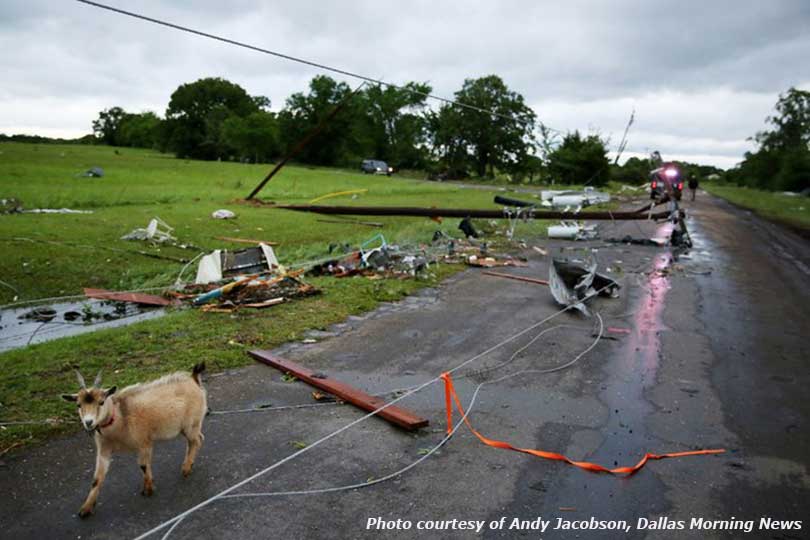Texas A&M AgriLife Extension Service agents and volunteers are assessing the damage caused by multiple tornadoes in East Texas near Canton on April 29.
AgriLife Extension mobilized emergency responses to affected areas in Henderson, Smith, Van Zandt, Rains and Wood counties following multiple confirmed tornadoes, high winds and flooding.
Van Zandt County, especially the Canton area, was hardest hit by the storm system, according to media reports. There were four confirmed deaths and dozens of people injured during the storm.
Tommy Phillips, AgriLife Extension agent in Van Zandt County, said the area is recovering from four tornadoes confirmed by the National Weather Service.
Preliminary reports by the weather service indicate two EF 3 tornadoes with winds between 136-165 mph and two EF 0 tornadoes with winds 65-85 mph caused widespread damage in those counties. One EF 3 tornado’s path was 51 miles long.
Phillips said efforts on April 30 revolved around searching for and rescuing residents and clearing debris from roadways. On May 1, he said there were intermittent reports about agricultural damages, such as crop and livestock losses, but those losses were not a top concern for people in the area.
There was widespread damage to homes and outbuildings, including several barns, he said.
“There were livestock losses, but we haven’t heard of any mass losses, just one to three per producer, but that could change as people really start looking over their properties,” Phillips told AgriLife Today. “We’ve only started to assess the damage at this point.”
Stephen Gowin, AgriLife Extension agent, Rains County, said producers near Emory were reporting losses and damages, but there is a “neighbor helping neighbor” mentality among residents.
Several barns were destroyed in the area, and one producer lost several acres of production greenhouses.
“It’s pretty devastating, but I think everyone is okay in our area,” Gowin said. “There are trees down everywhere, and some producers dealing with lost or misplaced cattle but that’s in a concentrated area and those producers have spoken with each other. Everyone is helping where they can, whether it’s mending a fence or clearing trees or gathering supplies.”
The Emory Livestock Auction on Texas Highway 19 offered to hold any stray cattle for owners with damaged fences.
Both Gowin and Phillips said fencing materials would be an initial need for farmers and ranchers in the affected areas. The Texas A&M Vet Emergency Team was onsite assessing and caring for companion animals and livestock.
A recovery center was set up at the Canton Fairgrounds, 24742 Texas Highway 64 in Canton. The center is processing volunteers and accepting monetary donations, supplies such as toothpaste, soap, detergent, cleaning supplies, food and volunteers.
A fund to help residents was set up at the First State Bank of Ben Wheeler.
Richard Baetz, Texas Commission on Environmental Quality (TCEQ) investigator for concentrated animal feeding operations in Tyler, said there were unconfirmed reports of mass cattle losses by dairy farmers and beef cattle operations but reminded residents to follow state guidelines when disposing of carcasses.
“We ask that people be mindful to not bury animals near surface water or wells and in areas where the water table is shallow,” Baetz said. “There are directions on disposal whether it is burying or burning and considerations for special circumstances, which this would apply.”
Contact the nearest TCEQ regional office for any additional questions.
Residents who lost cattle, fences or buildings should document losses and contact the U.S. Department of Agriculture’s Natural Resources Conservation Service and Farm Service Agency for possible emergency relief funds.
Larry Pierce, AgriLife Extension regional program leader in Overton, said AgriLife Extension agents are available to answer questions and direct producers to resources, including:
- Emergency Conservation Program, a cost-share program that will help restore fences and some structures damage.
- Livestock Indemnity Program, which basically pays for losses of livestock, will take time, also. Ranchers are a

